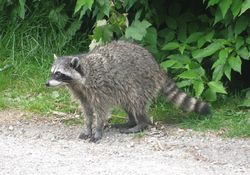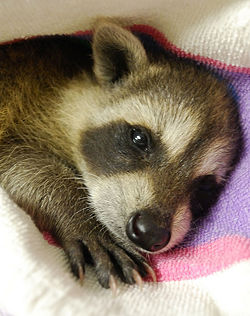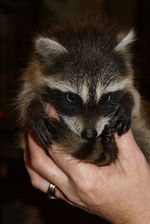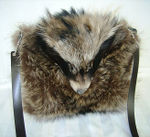Racoon
| Racoon |
|---|

|
| Scientific Classification |
|
| Trinomial Name |
|
Procyon lotor |
| baby racoon |
Racoons (also spelt raccoons) are native to North America. Its common colors are grey and black and are covered in thick underfur which helps during the cold weather. Two of the raccoon's most distinctive features are its extremely dexterous front paws and its facial mask. Raccoons are noted for their intelligence, with studies showing that they are able to remember the solution to tasks for up to three years. Their paws are incredibly capable of many things such as opening trash cans. Raccoons are very curious animals and like to wander around mainly at night because they are nocturnal meaning occurring or active at night. They are invasive to Germany but are not evasive in cities there.
Body Design
The raccoon is a small nocturnal mammal. Typically 20 - 30 inches long and weighing 15 - 60 pounds, in areas like cities is where they live on our trash and left over scraps. Their fur is grayish brown with a bushy ring type tail and black masked face. Raccoons appear to live in places where humans have built on the land. They are highly adaptable, and extremely intelligent animals that live well in cities, suburbs, and rural areas.[1]
Raccoons are omnivorous and will eat almost anything from fish, insects, eggs, and small animals to fruits, vegetables, and nuts and sometimes cats. Most active at night, raccoons sometimes also look for food by day. They will make their nests almost anywhere like: tree cavities, brush piles, abandoned burrows, chimneys, attics, crawl spaces, storm sewers, haystacks, and barn lofts—and usually have more than one living area available for use at any one time.[1]
Raccoons are as intelligent as dogs and cats. Their front arms provide them with great ability to use them almost like humans hands..[1]
Life Cycle
Mating season for raccoons falls generally anytime between January and June. Most females begin reproducing around the age of one. The female has a 65-day gestation period and gives birth to two to five kits (baby racoons), usually in the months of April and May. Mothers take real good care of the young and will even adopt young from another litter. The male does not participate in the raising of the kits. When they are born the black mask is already visible on their faces. The kits stay in the den with their mother and are nursed for 2-4 months until they are between 8-10 weeks old.[2] The family will generally stay together until the following Spring breeding season. Baby raccoons make a chattering sound when the mother returns from a night of exploring the neighborhood. This can be a good indicator that you have raccoons in your attic.[3]
Ecology
Although they have lived in lightly wooded areas in the last decades, raccoons depend on vertical structures like trees to climb when they feel afraid. Therefore, they avoid open areas with a lot of beech trees, as beech bark is too smooth to climb. Tree hollows in old oaks or other trees and rock crevices are preferred by raccoons as sleeping, winter, and litter dens. If those dens are unavailable or getting to them is to hard, raccoons use burrows dug by other mammals, thick undergrowth or tree cracks.
Though usually nocturnal, the raccoon is sometimes active in daylight to take advantage of available food. Its diet consists of about 40% invertebrates, 33% plant material and 27% vertebrates. While its diet in spring and early summer consists mostly of insects, worms, and other animals already available early in the year, it prefers fruits and nuts, such as acorns and walnuts which come in late summer and autumn, and represent a rich calorie source for building up fat needed for winter. Contrary to popular belief, raccoons eat active or large prey, such as birds and mammals only rarely, since they prefer prey that is easier to catch, specifically fish, amphibians and bird eggs. When food is plentiful, raccoons can develop strong likes for specific foods. In the northern parts of their area, raccoons go into a winter rest, reducing their activity as long as a permanent snow fall makes searching for food impossible.
Hunting
The fur or "hide" of a raccoon can be used for many different clothing items and decorations in houses. Although the hides were worth alot of money and high in demand in the 1920's, the price of a hide isn't in high demand or high in profit at this time. Native Americans were known to use raccoons as a food source and in years past barbecued raccoon featured as a specialty dish for holidays or special occasions. Most places see racoon as a pest and diseased critter, most don't eat raccoon. Some festivals still serve raccoon as a main dish, like the Delafield, Minnesota, "Coon Feed." For over 80 years, hundreds gather every year to eat slow roasted raccoon meat at this family festival. But some game hunters still hunt these animals fur the hats.Cite error: Invalid <ref> tag; invalid names, e.g. too many Racoons are still hunted to control them or just for the sport. They can be evasive to farms and cities or pretty much wherever there's food.[4]
Video
An example of what racoons do in the city....
References
- ↑ 1.0 1.1 1.2 About Raccoons Mission of the Massachusetts Society for the Prevention of Cruelty to Animals–Angell. Web. Accessed April 21, 2015. Unknown author.
- ↑ . Racoon Fact Sheet PBS. Web. Date-of-publication 2014.
- ↑ Critters Catches>. raccoon life cycle Critter Catchers, Inc. Web.Date accessed: 26 Jan. 2015. Author unknown.
- ↑ . Raccoon hunting basics Rock Dove Publications. Web.Date accessed: 14 Jan. 2015. Author unknown.





